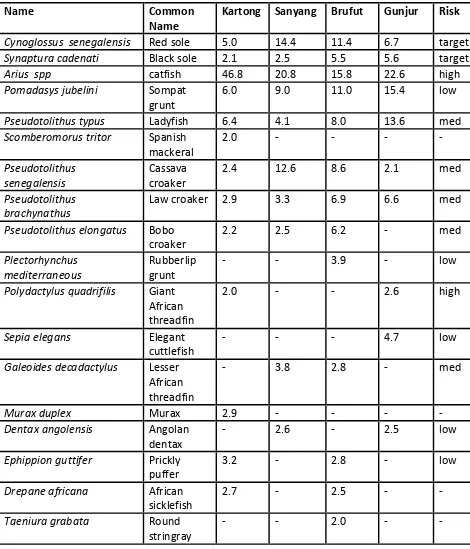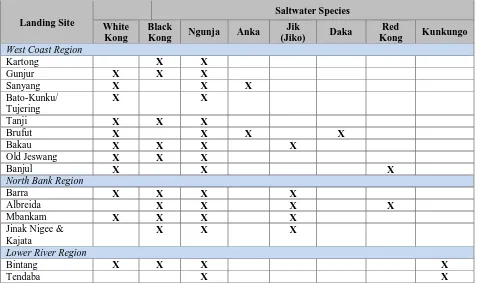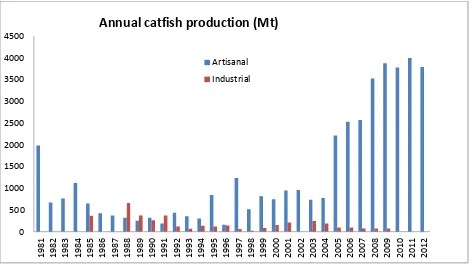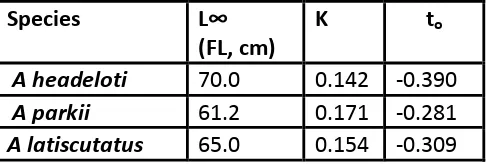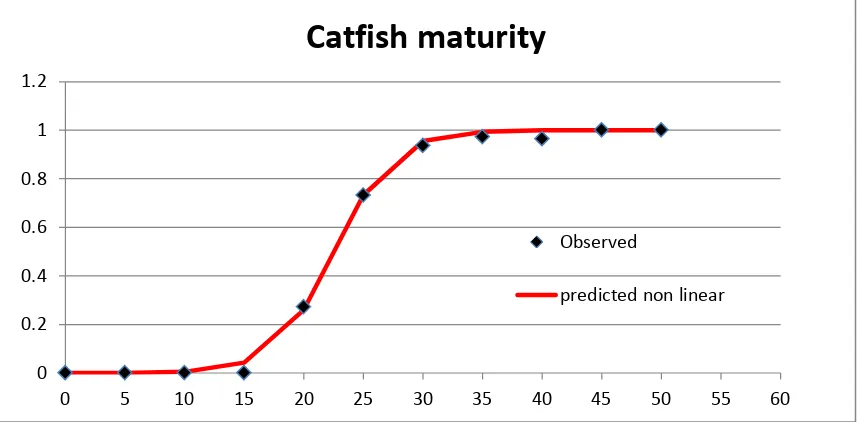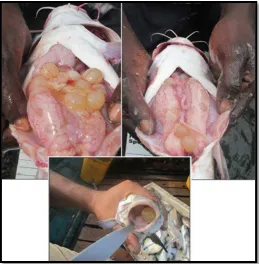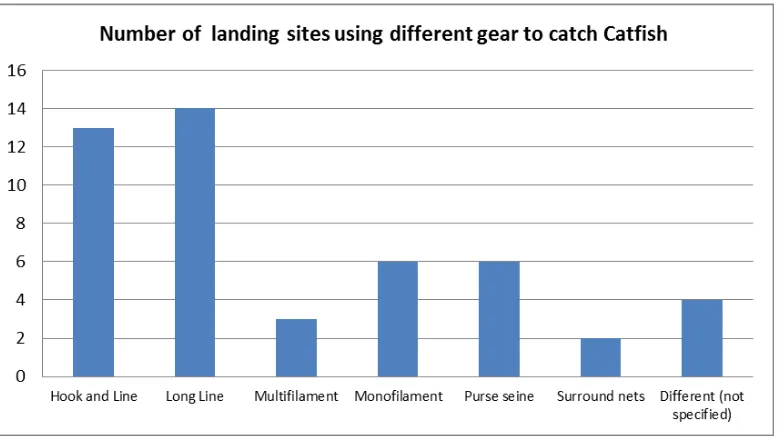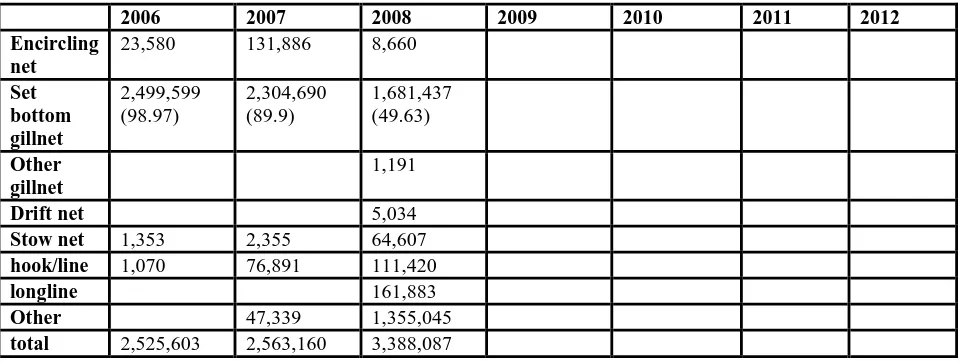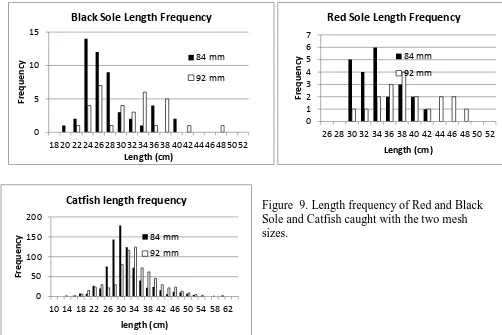MEMORANDUM OF UNDERSTANDING
DATE: December 16, 2013
BETWEEN: The National Sole Co-Management Committee (NASCOM)
AND: The Department of Fisheries
AND: The Ministry of Fisheries and Water Resources
SUBJECT: Amendment of the Fishery Co-Management Plan for The Gambia
Sole Complex to enlarge the scope to include marine Catfish and increase minimum mesh size for gillnets.
In accordance with Section 8.4 of the Fishery Co-Management Plan for The Gambia Sole Complex, Procedures for Adjusting Management Measures:
“Any subsequent changes to the management measures in this management plan will be detailed in a signed Memorandum of Understanding between NASCOM and Department of Fisheries and the Ministry of Fisheries, Water Resources and National Assembly Matters. This MOU will also detail any changes to the roles and responsibilities outlined in the management plan. “
The following Amendment specifies changes to the Co-Management Plan agreed to by the above parties.
The participatory, ecosystem-based co-management planning process for Sole undertaken by stakeholders in The Gambia since 2009 has highlighted the need for sustainable management practices that take into account a broader multi-species approach. This amendment is based on research, analysis and stakeholder
ii
FISHERY CO-MANAGEMENT PLAN FOR THE GAMBIA SOLE COMPLEX
Approved January 2012
AMENDMENT 1 (December 2013)
TO ENLARGE THE SCOPE TO INCLUDE MARINE CATFISH AND TO INCREASE MINIMUM MESH SIZE OF GILLNETS
Ministry of Fisheries and Water Resources
iii
TABLE OF CONTENTS
I. Co-Management Agreement ... v
II. Rationale for Expanding the Co-Management Plan Scope to Include Catfish . 1 III. The Marine Catfish Fishery ... 6
IV. Results of Mesh Size Gillnet Catch Comparison Study ... 14
V. Current Status of the Marine Catfish ... 17
VI. Management Measures ... 19
V. Research Priorities for Marine Catfish ... 20
References ... 21
List of Figures Figure 1. White kong, Arius parkii and Ngunja, Arius heudeloti. ... 6
Figure 2. Landings of all catfish species from the artisanal and industrial ... 7
Figure 3. Total catch of catfish by month in each site.. ... 8
Figure 4. Proportion mature of both Arius species combined ... 9
Figure 5. Eggs are large and a large amount of parental investment ... 10
Figure 6. Number of landing sites using different gear types ... 11
Figure 7. Longline used for catfish (Identified by fishermen). ... 11
Figure 8. Women cleaning catfish and the final smoked product ... 13
Figure 9. Length frequency of Red and Black Sole and Catfish. ... 16
Figure 10. Calculated Yield per Recruit (YPR) and Spawning Stock Biomass ... 17
iv
List of Tables
Table 1. Percent catch of primary species by site and risk index ... 4
Table 2. Ratio of target to bycatch species by site (by kgs) ... 5
Table 3. Landings by site (information from local knowledge survey). ... 6
Table 4. Von Bertalanffy growth parameters for Guinean catfish ... 8
Table 5. Age-length relationships calculated from growth. ... 9
Table 6. Rough Head Sea Catfish (kgs) ... 12
Table 7. Smooth Mouth Sea Catfish (kgs) ... 12
Table 8. Distribution of different artisanal smoked products ... 13
v
I. Co-Management Agreement
The Co-Management Agreement for the sole fishery is amended as follows:
WHEREAS, the sole fishery and the associated demersal finfish by-catch is an important resource that employs many people in the coastal zone, produces export earnings for the country, and is primarily an artisanal fishery,
WHEREAS marine catfish is an important utilized finfish by-catch of the sole fishery with high economic value and of local importance for food security and regional trade,
THEREFORE, I HEREBY
Declare that sole and marine catfish must be managed jointly as a multi-species fishery.
Designate the NASCOM and its associated LACOMs through the
Community Fisheries Center Management Committees as having exclusive use rights to the marine catfish fishery in the previously designated 9
nautical mile Special Management Area for the sole fishery.
vi
Signed:
_______________________________________________________ ____
Minister of Fisheries and Water Resources Date
Concur:
_______________________________________________________ ____ Director, Department of Fisheries Date
3
II. Rationale for Expanding the Co-Management Plan Scope to Include
Marine Catfish
During the pre-audit assessment conducted by the Marine Stewardship Council (MSC) in September 2008 for certification of the Gambian sole fishery, the lack of information on retained by-catch and ETP species was identified as a weakness for future management actions. Ninety-two potential non-target species had been identified by the MSC but insufficient data was available on these species to allow for a standardized assessment. 11 species were designated as high risk including catfish species.
In 2010-2011, the USAID/BaNafaa Project provided technical assistance for a bycatch assessment in the Gambian sole bottom gillnet fishery that was finalized in 2012. The conclusion of the study was as follows:
The bycatch assessment of the gillnet fishery has recorded many species of fish captured in this gear type. The target species, sole, is not the predominant catch. In most cases, the largest catch is of Cymbium species and marine catfish (Arius spp). Because of the vulnerability and importance of the catfish resource, this multispecies fishery must be considered when evaluating effect on the ecosystem of the sole gillnet fishery. Future recommendations include the development of a multispecies management plan to avoid overharvesting of sole fish and the vulnerable bycatch species such as catfish resources that will include recommendations for gillnet and longline fisheries.
Bycatch (or incidental catch) is commonly described as the unintended capture of species of fish. It will typically be retained for sale or use or discarded back to sea based on regulatory requirements or low value. By law, The Gambian fishermen are not permitted to discard, therefore all catch is landed regardless of its value, size or quantity.
Sole was reported as primarily harvested by the gillnet in the artisanal fishery. The multispecies nature of the fishery complex in the Gambia increases the probability of impact on non-target species. Over the last few years, there has been a change in the gillnet characteristics and fishing methods as fishermen place more of an
4 2) and identified as a high risk species necessitating measures for its management as part of the sole fishery.
Table 1. Percent catch of primary species (not including Cymbium species) by site and risk index (as determined by Medley et al., 2008).
Name Common
Name
Kartong Sanyang Brufut Gunjur Risk
Cynoglossus senegalensis Red sole 5.0 14.4 11.4 6.7 target
Synaptura cadenati Black sole 2.1 2.5 5.5 5.6 target
Arius spp catfish 46.8 20.8 15.8 22.6 high
Pomadasys jubelini Sompat
grunt
6.0 9.0 11.0 15.4 low
Pseudotolithus typus Ladyfish 6.4 4.1 8.0 13.6 med
Scomberomorus tritor Spanish mackeral
Pseudotolithus elongatus Bobo croaker
Polydactylus quadrifilis Giant African threadfin
2.0 - - 2.6 high
Sepia elegans Elegant
cuttlefish
- - - 4.7 low
Galeoides decadactylus Lesser African threadfin
- 3.8 2.8 - med
Murax duplex Murax 2.9 - - - -
Dentax angolensis Angolan dentax
- 2.6 - 2.5 low
Ephippion guttifer Prickly puffer
3.2 - 2.8 - low
Drepane africana African
sicklefish
2.7 - 2.5 - -
Taeniura grabata Round
stringray
5
Rhinoptera marginata Lusitanian cownose ray
- - - 3.3 med
Total weight of all catch (kg)
4103.0 5035.3 10641.3 6648.9
Table 2. Ratio of target to bycatch species by site (by kgs)
Name Common Name Kartong Sanyang Brufut Gunjur
Cynoglossus senegalensis TARGET 1 1 1 1
Synaptura cadenati
Arius spp catfish 6.58 1.2 0.93 1.83
Pomadasys jubelini Sompat grunt 0.84 0.54 0.65 1.25
Pseudotolithus typus Ladyfish 0.89 0.42 0.47 1.1
Scomberomorus tritor Spanish mackeral
Pseudotolithus elongatus Bobo croaker 0.31 0.15 0.37 -
Plectorhynchus mediterraneous
Rubberlip grunt - - 0.22 -
Polydactylus quadrifilis Giant African threadfin
0.27 - - 0.21
Sepia elegans Elegant
cuttlefish
- - - 0.37
Galeoides decadactylus Lesser African threadfin
- 0.22 0.17 -
Murax duplex Murax 0.40 - - -
Dentax angolensis Angolan dentax 0.15 0.21
Ephippion guttifer Prickly puffer 0.45 -- 0.16 -
Drepane africana African
sicklefish
0.37 - 0.15 -
Taeniura grabata Round stringray - - 0.11 -
Rhinoptera marginata Lusitanian cownose ray
6
III. The Marine Catfish Fishery
There are several species of marine, estuarine and freshwater catfish harvested from the Gambian waters. Recent interviews with local fishermen indicate that up to 8 species are found in saltwater while 6 are identified in estuary/freshwater environment (Table 3). Investigation in the beach landing sites positively identified three species: Arius latiscutatus (black kong or rough head sea catfish) Arius parkii (white kong) and Arius heudelot (Ngunja or smooth head sea catfish)(Figure 1).
Figure 1. White kong, Arius parkii and Ngunja, Arius heudeloti.
Table 3. Landings by site (information from local knowledge survey).
7 Catfish landings include all species of catfish. Catfish landings have been high since 2005 (Figure 2. Note that 2011 statistics are incomplete). Catfish were landed from bottom set gillnets at all sites for every month in the Gambia (Figure 3). Proportionally, landings of catfish were highest in Kartong in March-June; Highest in Brufut in November-January. The fishermen confirm the availability of catfish all year but note that peak is in the rainy season and the “Ngunga” species (Arius heudeloti) is found further off shore most of the year except the rainy season. This is the same pattern reported by Conand et al (1995) off the coast of Guinea.
Figure 2. Landings of all catfish species from the artisanal and industrial fisheries (Data from the Gambian Department of Fisheries).
0
Annual catfish production (Mt)
Artisanal
8 Figure 3. Total catch of catfish by month in each site (Data from bycatch survey). Note: Because the number of sampling trips varied, this graph can only be used to look at between site variation per month rather than a month to month comparison).
There is no data on growth of these species in the Gambia but data is available on the same species from Guinea (Table 4). Growth is believed to be seasonal with one annulus formed per year (using dorsal spine). No differences were noticed between males and females. The growth function parameters for Guinean catfish are listed in Table 5. In Guinea, there are fish in the landings greater than 80 cm which are assumed to be between 20-30 years old. Their natural mortality is believed to be low. Their morphology with the hard skull and strong protective spines probably protects them from strong predation pressure.
Table 4. Von Bertalanffy growth parameters for Guinean catfish (from Conand et al 1995).
Species L∞
(FL, cm)
K to
9 Table 5. Age-length relationships calculated from growth. Lengths given are fork lengths.
Age
The L50 for maturity is reported as between 27-28 cm for females (Age 3, Fishbase, 2012). Preliminary data from the Mesh Size Gillnet Study conducted in 2013 (Figure 4) point to slightly smaller L50 of 22.6 cm.
Figure 4. Proportion mature of both Arius species combined (for both male and female) L50=22.6
10 Figure 5. Eggs are large and a large amount of parental investment is evident as the eggs are mouth brooded by male up to 2 months.
Fishermen have observed spawning from May (Kartong and Gunjur) through September (Banjul). They believe the fish spawn inshore near the mouth of the river and bolongs. They produce a small number of eggs (Figure 5) which the males incubate in their mouths for up to 2 months (Fishbase, 2012).
11 Figure 6. Number of landing sites using different gear types (per local knowledge) for catfish
The Gambian Department of Fisheries maintains catch records per gear type for rough head sea catfish (A. latiscutatus) and smooth mouth catfish (A. heudelot) (in kg and percent of total catch). (2009-2012 data not yet available) (Tables 6 & 7).
12 Table 6. Rough Head Sea Catfish (kgs)
2006 2007 2008 2009 2010 2011 2012
total 2,525,603 2,563,160 3,388,087
Table 7. Smooth Mouth Sea Catfish (kgs)
2006 2007 2008 2009 2010 2011 2012
From this database, there has been a noticeable shift from gillnets to hook and line and longlines for the rough head sea catfish between the period from 2006-2008. The local knowledge survey conducted in 2012 verified that this trend has
continued.
13 The fish is arranged on the grill and covered creating a smoking chamber (Figure 8).
Figure 8. Women cleaning catfish and the final smoked product
After cooling, the product is packed in locally weaved baskets for marketing. 90% of the product is for the local market and 10% is exported (Table 8. Njai, 2000). Shelf life is believed to be 1- 3 days.
Table 8. Distribution of different artisanal smoked products according to markets (From Njai, 2000)
Market Products Estimated
share
Quantity (kg)
Value (US$ $/kg
Urban market Hot smoked shad Smoked dry shad
The MSC pre-assessment identified catfish species as high risk based on their productivity/susceptibility attributes (Medley et al., 2008). The combination of slow growth, large investment in small number of young, and long life span makes these species very susceptible to overfishing and needs to be closely monitored.
14 developed to prevent overfishing. A gillnet mesh study and stock assessment was conducted in 2012 and presented to NASCOM for evaluation.
Table 9. Summary of the findings of the Local Ecological Knowledge (LEK) and Scientific Knowledge studies on Catfish
LEK Findings Scientific Knowledge Findings
• Multiple species of salt, brackish and freshwater species identified.
• Most species caught year round, with peak periods based on species and location.
• Migration patterns generally from the North (Sine Saloum Senegal) and from deep waters North and West to The Gambia River through the river mouth in January and back to the sea when the rains start in June.
• At 4 sites prevalence of Ngunja (Arius heudeloti) is much less compared to the past. In Mbankam
fishermen have not seen Ngunja for the last 5 years. They can only catch it further south.
• Very slow growing; believed to live > 30 years.
• Produce only a few eggs per year; the male mouth- broods them for 2 months
• Mature between ages 2 and 3 (about 25cm fork length); can reach 80cm.
• Appear to be highly vulnerable to overfishing; may be overfished.
• By-catch survey showed large catches year round in all the sites
• Fishermen reported they catch catfish with gillnets, long lines and even purse seines.
• Note that the Marine Stewardship Council (MSC) process for eco-labeling will want to know percentages of catfish caught by the sole nets out of some total amount landed.
• Propose the need to be very proactive with catfish management to get the MSC label.
• Length frequency data would be useful.
• Suggest a hook selectivity study, along with gillnet.
15
IV. Results of Mesh Size Gillnet Catch Comparison Study
In 2013, USAID/BaNafaa provided technical assistance for a Mesh Size Gillnet Study. The previous 2012 study on the “Effect of Hanging Ratio on the Catch of Sole and Catfish in The Gambian Bottom Set Gillnet Fishery” determined some improvement to selection was possible. However, the added work of attaching the net to the hanging lines, difficulty of enforcement and the loss of fish makes this feature unattractive as a management measure. Therefore, the committee opted to examine the increase of mesh size as a possible management option. This study was designed to determine mean size of fish caught with the 84 and 92 mm mesh size.
Four crew were involved in the study (2 local fishers and 2 from the
USAID/BaNafaa team). The fishing trials were conducted in a 5 nautical mile radius off the coast of Kartong on the Atlantic coast of The Gambia, locally known to be a hotspot for the Sole fishery and other locally important fish species. Fishing trials were conducted from May 25-June 22, 2013 resulting in 29 net hauls. Two monofilament nets (one with 84 mm mesh, one with 92 mm mesh, and both 720 meters long) were fished side by side. Both nets were hauled every 24hrs. Data on species, length, weight, gear type and mesh size were recorded.
The overall results of the catch comparison of the 84 mm and 92mm bottom gillnet used in the study indicate that significantly larger Sole, Catfish, Sompat grunt, Bigeye grunt, Lesser African threadfin and butterfish are caught with the larger 92 mm mesh net than in the 84 mm net.1 Both nets caught most of the same species and the total number captured was not considerably different between the two nets.
1
16 Figure 9. Length frequency of Red and Black Sole and Catfish caught with the two mesh sizes.
The study concludes that increased mesh size has the potential to be a meaningful management tool for the Sole and Catfish fisheries while also improving the status of grunt and butterfish. Current mandated minimum mesh and fish size have been arbitrarily determined. New (although not complete) information on sole maturity can now be matched with mean size of fish captured using different mesh sizes. With better biological information, it will greatly improve harvesting rules and fishery sustainability. For example, preliminary data indicate that 50% maturity of Catfish (Arius spp) occurs between 20-25 cm lengths reaching 100% maturity at 30 cm. Increasing mesh size to 84 or 92 mm will shift the mean size of fish captured to between 31-34 cm. Although the current mandated minimum mesh size is 80 mm, fisherman use both the 84 mm and 92 mm stretch mesh, so conversions can be made rapidly and easily.
Black Sole Length Frequency
84 mm
Red Sole Length Frequency
17
V. Current Status of the Marine Catfish
A preliminary stock assessment for catfish species was conducted in 2013.
Figure 10. Calculated Yield per Recruit (YPR) and Spawning Stock Biomass per Recruit (SBPR) Reference points for catfish.
Figure 11. Catch curve analysis showing plot of age and ln (number). This regression line produces an estimate of Z, total mortality of 0.65.
y = -0.6484x + 7.6997 R² = 0.9746
0 1 2 3 4 5 6
0.0 2.0 4.0 6.0 8.0 10.0 12.0 14.0
Ln
(n
u
m
b
e
r)
18 The results of the length-based catch curve (LCCA) analysis suggests that the best estimate of fishing mortality (F) for catfish species is 0.45 based on Lmax , K and M values of 72 cm, 0.154 and 0.2 for combined species.
The reference points for growth and recruitment overfishing, Fmax and F30%, for catfish are 0.27 and 0.26, respectively. Comparing the results of the LCCA to the reference points estimated in the YPR and SSBPR analysis, catfish experienced growth and recruitment overfishing in 2013.
Species F
calculated
F max F30% Conclusion
Catfish 0.45 0.27 0.26 Recruitment overfishing; growth overfishing
Immediate action is recommended to reduce fishing mortality of the catfish species. The 1 nm closed area and season from May-October put in place for sole should protect the marine catfish during their spawning season and an increased mesh size in the gillnet will increase the mean size of animal captured. A
recommended immediate study would be to evaluate hook size selection in the longline fishery. The National Sole Fishery Co-Management Committee
19
VI. Management Measures
The Current Management Measures for Sole documented in section 8.1 of the Co-Management Plan are revised as follows:
1. Minimum mesh size for gillnets (stretched) for Sole and Catfish: 92mm.
This revision is based on the results of the Mesh Size Gillnet Study conducted in 2013 that shows increased mesh size to be an effective measure for selecting larger fish for both Sole and Catfish, thereby tending to minimize the number of
immature individuals caught, helping to prevent growth and recruitment
overfishing. The increase in mesh size specified in this amendment is taken as a conservative, preventive management measure. This mesh size revision will take effect on May 1, 2014.
The New Management Measures for Sole documented in section 8.2 of the Co-Management Plan are also appropriate for sustainable management of Catfish and other demersal species without revision as follows:
1. The no take zone one nautical mile from the coastline for all fishing from May 1 through October 31 for all fish species and all gear types.
The Local and Scientific Knowledge gathered to date and documented above on the spawning areas and spawning times of catfish caught by artisanal fishermen in The Gambia indicate that they spawn in near shore areas during the May – October period.
20
V. Research Priorities for Marine Catfish
Collection of data needed to establish baseline stock assessment:
• Length frequency at landing sites • Effort by gear type
• Data by species
Recommend the following strategy
• Length frequency data collected in April and November for each year. • Establish a study fleet for catch and effort data
• DOFISH collect monthly landings information from all landing sites.
Biological Data:
• Maturity- increase sample sizes • Age using dorsal spine
• Length weight-increase sample sizes
Data on the Fishery
• Hook selectivity studies
21
References
K. Castro, Jallow, A. and S. Cessay. 2013. Description and analysis of the Gambia catfish stock assessment- 2013.
Gabis, G., Drammeh,O.,Nichols, E., Kelpsite,L., Castro, K., Parkins,C., Mendy, A., Ceesay, S.and F. Joof. 2012. Bycatch Assessment in the Gambian Sole Bottom Gillnet Fishery. Gambia-Senegal Sustainable Fisheries Project (USAID/Ba Nafaa). Coastal Resources Center, University of Rhode Island, pp. 20.
Gabis, G., Nichols, E., Kelpsaite, E., Parkins,C., Castro, K. and B. Somers, 2012. Guide for the Identification of Commonly Caught Fish in the Bottom Set Gillnet Fishery in the Gambia, Coastal Resources Center, University of Rhode Island, pp.68
Gabis, G., Drammeh, O. and L. Kelpsaite. 2012 The Use of Local Knowledge – Application to the Management of the Catfish Fishery in the Gambia.
Gabis, G., Kelpsaite, L., Parkins, C. and K. Castro. 2012. Effect of Hanging Ratio on the Catch of Red Sole (Cynoglossus senegalensis), Black Sole (Synaptura cadenati) and Catfish (Arius spp) in The Gambian Bottom Set Gillnet Fishery, CRC, URI, 16 pps.
